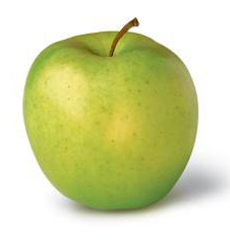RECIPE: Apple Sangria
 Ready for a glass? You can use red and green apple slices, in addition to the strawberries, for extra color. Photo courtesy U.S. Apple Association. |
It’s so hot here today (87°F) that we can’t get into fall recipes. But this Apple Sangria recipe is a compromise, turning the most popular fall flavor into a refreshing drink.
There are actually two recipes below: the first, sangria with Calvados and sparkling wine; the second, a mocktail. The first recipe makes eight 8-ounce servings or ten 6-ounce servings. If you don’t have Calvados (apple brandy), you can substitute plain brandy or Cognac. Ingredients |
|
|
Preparation 1. MIX the Calvados and brown sugar in a large pitcher until the sugar is dissolved. Stir in the apple juice, apple, strawberries and grapes. Cover and refrigerate for 2 hours or more. 2. ADD the sparkling wine just before serving and gently stir (you don’t want to break the bubbles). Pour into ice-filled glasses. |
||
|
APPLE SANGRIA MOCKTAIL This recipes makes eight 8-ounce, or ten 6-ounce, servings of non-alcoholic sangria. Ingredients 1. COMBINE the apple juice, apple, strawberries and grapes. Cover and refrigerate for 2 hours or more. 2. ADD the club soda and sparkling cider just before serving and gently stir. Pour into ice-filled glasses. |
 The Crispin apple, also known as Mutsu, has a green skin. Honeycrisp apples have a red skin. Photo courtesy New York Apple Association. |
|
|
THE HISTORY OF SANGRIA Around 200 B.C.E., the conquering Romans arrived in Spain and planted vineyards. They soon discovered that red grape varietals produced the best wine in the local soils. While some was enjoyed locally, the majority of the wines were shipped to Rome. The locals created fruit punches from the wines and called these drinks sangria after the Spanish word for bloodletting. While sangria was drunk in Spain for more than 1,000 years, it didn’t arrive in the U.S. until 1964—at the Spanish Pavilion at the World’s Fair in New York. It was quickly adopted by Americans. Since January 2014, the use of the word “sangria” on bottle labels is restricted by the European Union. Only sangria made in Spain and Portugal can be sold under that name. Sangaree, a fruit and wine punch from the West Indies, is the same drink. The name is an archaic English term for sangria. December 20th is National Sangria Day. Here’s more about sangria. |
||


